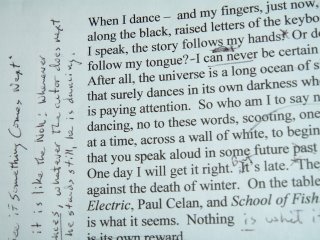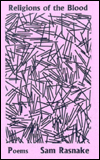shadows come to life...
from my anthology of must read (a)merican poems
Nin Andrews
What Is It About the Past
the Old Country where the children we were
walk around in black and white
movies, long nights with bugs
flying in my window, dreams
slippery as wet fish, moans
in the air from our parents’ room? Horses
kicked at their stalls, heat
shivered in the summer skies. Sleepless
we held our breath, saw shadows
come to life and pulled them inside
us, shutting our eyes. I denied
they existed, denied
we existed, remembering the nuns
at school who wore black to hide
their whiteness, wore black
to show us they were servants
of God. I still dream them at night
lifting their heavy gowns
as the past unreels, a soundless
movie on a white wall with nobody watching.
*
“What Is It About the Past” resonates for me as a companion piece of sorts to Stanley Kunitz’ marvelous “Three Floors” – a poem about memory that recreates childhood, loss, sounds and shadows in a near horrific way. I doubt that Andrews had Kunitz’ poem in mind when she wrote her lines, but both poems approach the subject and theme in similar fashion.
Andrews’ poem creates an accurate scene of the solitude required for memory. Note the closing lines that carry the motion of the past:
a soundless
movie on a white wall with nobody watching
All the pieces of a life that define, not so much its worth, but its specific qualities. The poet’s use of enjambments, of various forms, is forceful and accelerates the read in the lines: bugs / flying, Horses / kicked, heat / shivered, shadows / come, night / lifting. This is a strong and satisfying quality in the poetry. Enjambments of a more descriptive nature such as dreams / slippery and soundless / movie reflect the brokenness of the speaker’s world. This technique adds a certain discordant quality that supports the fragmentary nature of memory and the uncertainty implied in the poem’s title.
The opening stanza focuses on the physical world of walking and nights and bugs and moans. Although the actions become increasingly disjointed as the poem progresses, the setting remains a familiar one. Andrews is gifted at creating a reality that is complete with sight and sound, but this reality does fracture. The “nights / with bugs flying” shifts to “shadows come to life” and the disturbing dream of nuns, in black and white – the imagery referencing not just the clothing but also an absence of color or reality in the dream – “at night / lifting their heavy gowns”. With each line, the speaker becomes more remote and withdrawn, yet is able to connect with and involve the reader in a clear, inescapable way.
Andrews closes the poem with a paradox: the soundless movie that unreels with no one watching – a memory that is being uncovered, at least in part, though never fully explained. The reader sees all, yet nobody is watching. The image continues to move beyond the space and boundary of the piece. I find that amazing and appealing, and a perfect ending for the work.









No comments:
Post a Comment